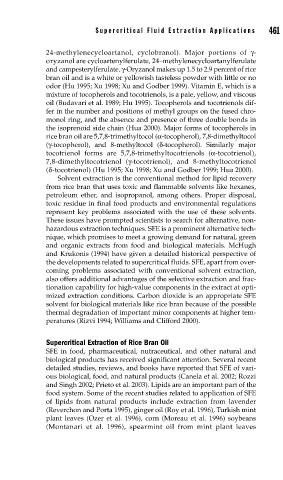Page 489 - Biosystems Engineering
P. 489
Super critical Fluid Extraction Applications 461
24-methylenecycloartanol, cyclobranol). Major portions of γ-
oryzanol are cycloartenylferulate, 24–methylenecycloartanylferulate
and campesterylferulate. γ-Oryzanol makes up 1.5 to 2.9 percent of rice
bran oil and is a white or yellowish tasteless powder with little or no
odor (Hu 1995; Xu 1998; Xu and Godber 1999). Vitamin E, which is a
mixture of tocopherols and tocotrienols, is a pale, yellow, and viscous
oil (Budavari et al. 1989; Hu 1995). Tocopherols and tocotrienols dif-
fer in the number and positions of methyl groups on the fused chro-
monol ring, and the absence and presence of three double bonds in
the isoprenoid side chain (Hua 2000). Major forms of tocopherols in
rice bran oil are 5,7,8-trimethyltocol (α-tocopherol), 7,8-dimethyltocol
(γ-tocopherol), and 8-methyltocol (δ-tocopherol). Similarly major
tocotrienol forms are 5,7,8-trimethyltocotrienols (α-tocotrienol),
7,8-dimethyltocotrienol (γ-tocotrienol), and 8-methyltocotrienol
(δ-tocotrienol) (Hu 1995; Xu 1998; Xu and Godber 1999; Hua 2000).
Solvent extraction is the conventional method for lipid recovery
from rice bran that uses toxic and flammable solvents like hexanes,
petroleum ether, and isopropanol, among others. Proper disposal,
toxic residue in final food products and environmental regulations
represent key problems associated with the use of these solvents.
These issues have prompted scientists to search for alternative, non-
hazardous extraction techniques. SFE is a prominent alternative tech-
nique, which promises to meet a growing demand for natural, green
and organic extracts from food and biological materials. McHugh
and Krukonis (1994) have given a detailed historical perspective of
the developments related to supercritical fluids. SFE, apart from over-
coming problems associated with conventional solvent extraction,
also offers additional advantages of the selective extraction and frac-
tionation capability for high-value components in the extract at opti-
mized extraction conditions. Carbon dioxide is an appropriate SFE
solvent for biological materials like rice bran because of the possible
thermal degradation of important minor components at higher tem-
peratures (Rizvi 1994; Williams and Clifford 2000).
Supercritical Extraction of Rice Bran Oil
SFE in food, pharmaceutical, nutraceutical, and other natural and
biological products has received significant attention. Several recent
detailed studies, reviews, and books have reported that SFE of vari-
ous biological, food, and natural products (Canela et al. 2002; Rozzi
and Singh 2002; Prieto et al. 2003). Lipids are an important part of the
food system. Some of the recent studies related to application of SFE
of lipids from natural products include extraction from lavender
(Reverchon and Porta 1995), ginger oil (Roy et al. 1996), Turkish mint
plant leaves (Ozer et al. 1996), corn (Moreau et al. 1996) soybeans
(Montanari et al. 1996), spearmint oil from mint plant leaves

